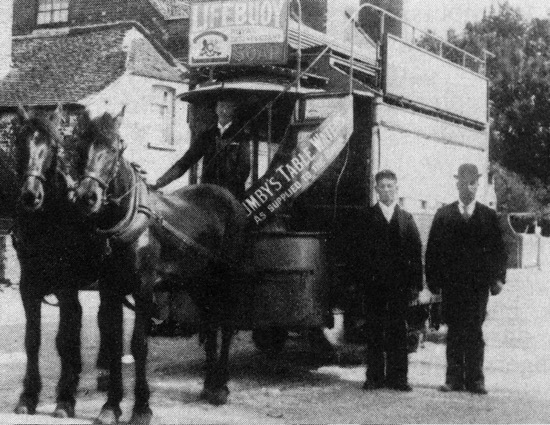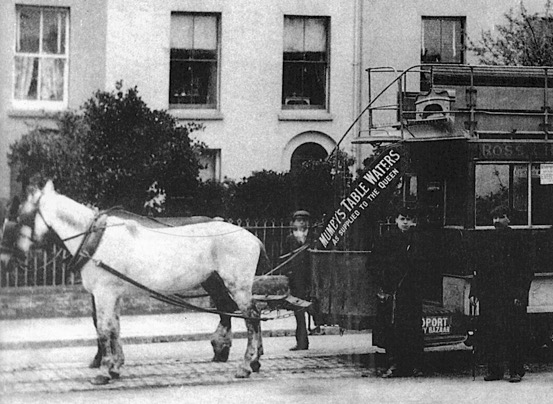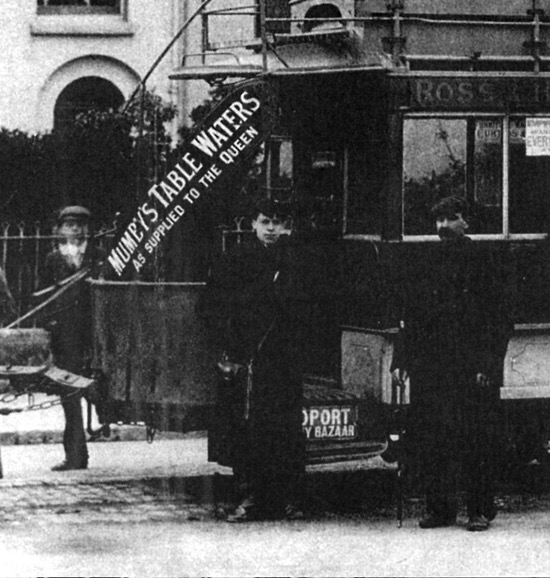Gosport Street Tramways
History
In 1879, the London-based Provincial Tramways Company promoted a scheme to build a horse tramway in Gosport and Alverstoke. The PTCo, which had been formed seven years previously on the 10th July 1872, would eventually be involved in tramway operation for over fifty years, either owning, controlling or operating: Borough of Portsmouth, Kingston, Fratton and Southsea Tramways; Cardiff Tramways; Cardiff District and Penarth Harbour Tramways; General Tramways of Portsmouth; Gosport Street Tramways; Gosport and Fareham Tramways; Great Grimsby Street Tramways; the Landport and Southsea Tramway; London Southern Tramways; Plymouth, Stonehouse and Devonport Tramways; the Portsdown and Horndean Light Railway; and Portsmouth Street Tramways.
Powers to construct 3.3 miles of standard-gauge horse tramway were granted on the 23rd May 1879 under the Gosport Street Tramways Act, 1879; the act also incorporated a subsidiary company — the Gosport Street Tramways Company — to build and operate the tramway.
For reasons now unclear, at a meeting held on the 26th February 1881, the PTCo decided to postpone construction. The most likely explanation is that the company had had problems raising the capital, but more pressing, was the looming expiration of the company's powers, the act stipulating that the tramway must be completed within two years of the Royal Assent, i.e., May 1881. Although the company was therefore forced to apply for powers to extend the time allowed, it also used the opportunity to reduce the gauge of the tramway to 3ft (though later Board of Trade returns state it to have been 3ft 6ins), to extend the line to Brockhurst and Fareham, and to use steam traction. These powers were granted on the 3rd June 1881 under the Gosport Street Tramways Act, 1881.
Although the new act extended the time allowed for completion of the tramway by a year — to the 23rd May 1882 — construction did not commence until the 7th February 1882, which clearly left little time to complete it. Following a request to defer the inspection, the tramway was finally opened between Gosport Beach (the Hard) and Anns Hill on the 17th July 1882, with an extension northwards to Brockhurst opening on or around the 1st February 1883. This took the horse tramway to its final size of 2.25 miles, the line running westwards from the Hard along High Street, then turning northwards along Clarence Road, before winding its way northwestwards via Forton Road and Brockhurst Road to a terminus in Brockhurst at the junction of Brockhurst Road and Elson Lane.
Neither of the authorised lines northwards to Fareham and southwestwards to Alverstoke were ever built, nor was steam traction ever introduced.
On the 1st September 1883, the GSTCo was amalgamated with two Portsmouth-area tramway companies (the Portsmouth Street Tramways Company, and the General Tramways Company of Portsmouth) both of which were owned by the PTCo. Powers for this, as well as the formation of a new statutory company — the Portsmouth Street Tramways Company — were granted on the 16th July 1883 under the Portsmouth Street Tramways (Amalgamation) Act, 1883.
From this moment onwards, the affairs of the GST were bound up with those of the Portsmouth Street Tramways Company, its owner and operator. Whilst the PSTCo was certainly a profitable concern, the precise contribution of the GST to this is unclear.
In the late 1890s it was clear to the PTCo that Portsmouth Corporation would compulsorily purchase all the company's lines in Portsmouth (as well as its Cosham line, which was just to the north of the borough), leaving it with the small system in Gosport. Although the latter was also threatened by municipalisation, it escaped this fate due to the local authority — Gosport and Alverstoke Urban District Council — failing to follow the process laid out in the Tramways Act, 1870 (when serving notice on the company in late 1900).
At midnight on the 31st December 1900, the PSTCo duly lost all its lines within Portsmouth to the corporation, which left it to ponder what it should do with its Gosport operation. During 1901, it decided to offload the tramway by offering it to the Urban District Council, but was rebuffed. Somewhat reluctantly, the PSTCo then decided to proceed with a scheme to convert the horse tramway to overhead electric traction, and to extend it northwards to Fareham, and southwestwards to Bury Cross (an additional 5.7 miles in total). Powers to this end were granted on the 11th August 1903 under the Gosport and Fareham Tramways Act, 1903.
Construction of the new tramway, which was built to the wider gauge of 4ft 7¾ins, commenced in early 1905, the last narrow-gauge horse tram service presumably running some time in 1905 (the precise date has not been recorded). This was, however, not to be the last horse tram service in Gosport, as problems were encountered with the power plant, leading to the deployment of some old 4ft 7¾ins-gauge PSTCo horse trams as a temporary measure. The PSTCo's new electric tramway — Gosport and Fareham Tramways (see link) — opened on the 24th January 1906, the last horse tram services running the previous day.
Uniforms
Photographs of Gosport horse trams taken during the 13-month period it was operated by the Gosport Street Tramways Company (July 1882 to August 1883) appear not to have survived, so it is currently impossible to say whether or not uniforms were issued. However, given that there is no evidence that uniforms were worn on any of the Provincial Tramways Company systems in Portsmouth, it is almost certain that staff of the GSTCo wore informal attire.
Although photographs of Gosport horse trams taken during its Portsmouth Street Tramway Company days (1883 to circa 1905) are scarce, several have survived that were taken around the turn of the century. These clearly show that tramcar staff wore informal but smart attire, comprising greatcoats or coachmen's coats, jackets, shirts, ties and the fashionable headgear of the day, either the bowler hat, or the flat cap. No insignia of any kind appears to have been worn, including municipal licence badges.
Photographs of inspectors have not survived, and it is entirely possible that the Gosport Street Tramways Company never employed them.
Further reading
For a detailed history of the area's tramways, see 'Tramways of Portsmouth' by S E Harrison, Light Railway Transport League (1955), and 'Provincial Paper No 2' by Stewart Brett, The Provincial Society (2014).
Images
Horse tram drivers and conductors
Driver George Felmingham and Conductor Arnold pose for the cameraman near the Wheatsheaf pub in Brockhurst in 1897. Both men are wearing smart, but informal attire. Photo courtesy of the Tramways and Light Railway Society, with thanks to David Voice.
A double-deck GSTCo horsecar with crew — photo undated, but thought to have been taken around the turn of the century. Photo courtesy of the Tramways and Light Railway Society, with thanks to David Voice.
An enlargement of the above photograph showing the conductor, in greatcoat with cash bag, and the driver (William Hibdige) also in a long greatcoat or coachman's coat, and wearing a flat cap.